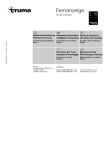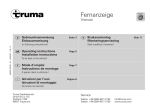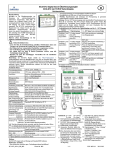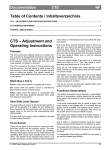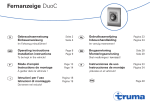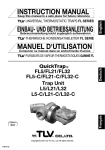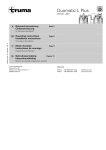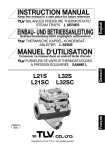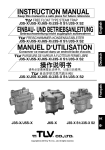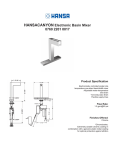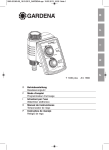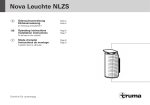Download Gasfernschalter
Transcript
50020-13600 · 05/00 · 2’B+W · © Gasfernschalter Gebrauchsanweisung Operating instructions Mode d’emploi Einbauanweisung Installation instructions Instructions de montage Im Fahrzeug mitzuführen! To be kept in the vehicle! À garder dans le véhicule! Seite 1 Page 3 Page 5 Truma Gerätetechnik GmbH & Co Postfach 1252 D-85637 Putzbrunn Service Telefon +49 (0) 89 46 17-142 Telefax +49 (0) 89 46 17-159 e-mail: [email protected] http://www.truma.com 50020-13600 · 05/00 · 2’B+W · © Gasfernschalter Gebrauchsanweisung Operating instructions Mode d’emploi Einbauanweisung Installation instructions Instructions de montage Im Fahrzeug mitzuführen! To be kept in the vehicle! À garder dans le véhicule! Seite 1 Page 3 Page 5 Truma Gerätetechnik GmbH & Co Postfach 1252 D-85637 Putzbrunn Service Telefon +49 (0) 89 46 17-142 Telefax +49 (0) 89 46 17-159 e-mail: [email protected] http://www.truma.com Gasfernschalter 2 1 4 B D 8 1 6 3 min. 50 cm 6 7 3 min. 50 cm A 7 10 9 11 6 Duomatic E C 5 6 3 min. 50 cm 1 7 1 2 3 4 1 3 4 + Triomatic – 6 10 Gasfernschalter 2 1 4 B 8 6 7 3 min. 50 cm 6 3 min. 50 cm D 1 7 10 9 11 6 Duomatic E C 5 6 1 3 7 min. 50 cm A 1 2 3 4 1 3 4 Triomatic + 10 – 6 TrumaGasfernschalter Hauptabsperrventil für die Gasversorgung, vom Innenraum aus zu bedienen Die Gasflaschen bleiben während der Nutzungsdauer des Fahrzeuges geöffnet. Wird die Gasversorgung längere Zeit nicht benutzt, sollten die Gasflaschen geschlossen werden. Gasversorgung einschalten Gebrauchsanweisung Gasfernschalter a c b Am Bedienteil linken Schalter (a) auf „Ein“. Betriebsanzeige (c) leuchtet. Rechten Wippschalter (b) zum Öffnen kurz antasten (um eine Überlastung der Magnetspule zu vermeiden, nicht längere Zeit auf der Wippe bleiben!). Achtung: Bei einer Stromunterbrechung schließt das Magnetventil und muß durch kurzes Antasten des rechten Wippschalters (b) neu eingeschaltet werden! Vor Dichtprüfung Gasfernschalter öffnen. fernschalter aus dem Leitungssystem herausgeschraubt werden. Technische Daten Durchflußmenge: 1 kg/h Gasrohranschluß GS 8: Zapfen Ø 8 mm GS 10: Zapfen Ø 10 mm Max. Druck: 150 mbar Nennspannung: 12 V DC Stromverbrauch: 40 mA kurzzeitig (Öffnen) 1 A Schutzart: IP 54 Produkt-Ident-Nummer: CE-0085AS0506 Ventilklasse: A, Gruppe 2 Umgebungstemperatur: -20° C bis +60° C Öffnungs- und Schließzeit: < 1s Einbaulage: beliebig Schmutzsieb im Gaseingang integriert. Einbau und Reparatur des Gasfernschalters darf nur vom Fachmann durchgeführt werden. Montage an die Einflaschen-Gasanlage Bild A: Magnetventil (1) zwischen Gasschlauch (2) und Gasleitung (3) montieren. Montage an die Zweiflaschen-Gasanlage Bild B, Truma-Duomatic: T-Stück (4) an der Gasleitung (3) abschrauben. Magnetventil (1) auf Gasleitung (3) montieren und T-Stück (4) am Magnetventil (1) anschließen. Bild C, Truma-Triomatic: Gasleitung (3) am Anlagenregler (5) abschrauben. Magnetventil (1) auf Gasleitung (3) montieren und Anlagenregler (5) am Magnetventil (1) anschließen (evtl. mit einem geeigneten Rohrschneider keine Säge - kürzen). Gasversorgung ausschalten a = Schalter „Ein/Aus“ b = Starter c = Betriebsanzeige Einbauanweisung Linken Schalter (a) auf „Aus“. Betriebsanzeige (c) erlischt. Bei Defekt oder Stromausfall kann der Gas- 1 TrumaGasfernschalter Hauptabsperrventil für die Gasversorgung, vom Innenraum aus zu bedienen Die Gasflaschen bleiben während der Nutzungsdauer des Fahrzeuges geöffnet. Wird die Gasversorgung längere Zeit nicht benutzt, sollten die Gasflaschen geschlossen werden. Gasversorgung einschalten Gebrauchsanweisung Gasfernschalter a c a = Schalter „Ein/Aus“ b = Starter c = Betriebsanzeige b Am Bedienteil linken Schalter (a) auf „Ein“. Betriebsanzeige (c) leuchtet. Rechten Wippschalter (b) zum Öffnen kurz antasten (um eine Überlastung der Magnetspule zu vermeiden, nicht längere Zeit auf der Wippe bleiben!). Achtung: Bei einer Stromunterbrechung schließt das Magnetventil und muß durch kurzes Antasten des rechten Wippschalters (b) neu eingeschaltet werden! Vor Dichtprüfung Gasfernschalter öffnen. Gasversorgung ausschalten Linken Schalter (a) auf „Aus“. Betriebsanzeige (c) erlischt. Bei Defekt oder Stromausfall kann der Gas- fernschalter aus dem Leitungssystem herausgeschraubt werden. Technische Daten Durchflußmenge: 1 kg/h Gasrohranschluß GS 8: Zapfen Ø 8 mm GS 10: Zapfen Ø 10 mm Max. Druck: 150 mbar Nennspannung: 12 V DC Stromverbrauch: 40 mA kurzzeitig (Öffnen) 1 A Schutzart: IP 54 Produkt-Ident-Nummer: CE-0085AS0506 Ventilklasse: A, Gruppe 2 Umgebungstemperatur: -20° C bis +60° C Öffnungs- und Schließzeit: < 1s Einbaulage: beliebig Schmutzsieb im Gaseingang integriert. Einbauanweisung Einbau und Reparatur des Gasfernschalters darf nur vom Fachmann durchgeführt werden. Montage an die Einflaschen-Gasanlage Bild A: Magnetventil (1) zwischen Gasschlauch (2) und Gasleitung (3) montieren. Montage an die Zweiflaschen-Gasanlage Bild B, Truma-Duomatic: T-Stück (4) an der Gasleitung (3) abschrauben. Magnetventil (1) auf Gasleitung (3) montieren und T-Stück (4) am Magnetventil (1) anschließen. Bild C, Truma-Triomatic: Gasleitung (3) am Anlagenregler (5) abschrauben. Magnetventil (1) auf Gasleitung (3) montieren und Anlagenregler (5) am Magnetventil (1) anschließen (evtl. mit einem geeigneten Rohrschneider keine Säge - kürzen). 1 Elektrischer Anschluß Anschlußkabel (6) des Magnetventils mit Isolierband parallel zum Gasrohr (3) verlegen und nach innen zum vorgesehenen Platz für das Bedienteil (8) verlegen. Falls erforderlich, mit einem Kabel 3 x 0,75 mm2 verlängern. Achtung: Der Anschluß der Verlängerung darf nicht im Flaschenkasten erfolgen! Für Flaschenkasten-Durchführung (7) Gummitülle oder Karosseriedichtmittel verwenden. Durchführung mindestens 50 cm über dem Boden des Flaschenkastens oder in einem Schutzrohr verlegt - vorsehen. Bild D: Platz für das Bedienteil (8) an gut sichtbarer Stelle vorsehen. Loch Ø 10 mm für die Kabeldurchführung (9) bohren. Anschlußkabel des Magnetventils (6) und 12 V Zuleitung (10) von hinten durch die Kabeldurchführung (9) in der Wand führen und gemäß Anschlußschema (Bild E) am Bedienteil anklemmen. 1 2 3 4 = = = = braun gelb grün weiß Bedienteil mit den 2 beiliegenden Senkkopfschrauben (11) befestigen. Für die „Unterputz-Montage“ des Bedienteils liefert Truma als Sonderzubehör einen Bedienteilrahmen (Art.Nr. 39980-01). Funktionsprüfung Nach dem Einbau muß die Dichtheit der Gasanlage geprüft werden. Anschließend gemäß der Gebrauchsanweisung sämtliche Funktionen des Gerätes prüfen. Die Gebrauchsanweisung ist dem Betreiber auszuhändigen! Gerät am abgesicherten Bordnetz (Zentralelektrik 5 10 A) mit Kabel 2 x 0,75 mm2 anschließen. Bei direktem Anschluß an die Batterie ist die Plus- und Minusleitung abzusichern. Alle Kabel mit Kabelschellen sichern. Bei Verwendung von Netzteilen ist zu beachten, daß das Gerät nur mit Sicherheitskleinspannung nach EN 60742 betrieben werden darf. Hinweis: Es ist auch möglich, den Gasfernschalter mit einem Gaswarngerät oder einem Hauptschalter zu kombinieren. 2 Elektrischer Anschluß Anschlußkabel (6) des Magnetventils mit Isolierband parallel zum Gasrohr (3) verlegen und nach innen zum vorgesehenen Platz für das Bedienteil (8) verlegen. Falls erforderlich, mit einem Kabel 3 x 0,75 mm2 verlängern. Achtung: Der Anschluß der Verlängerung darf nicht im Flaschenkasten erfolgen! Für Flaschenkasten-Durchführung (7) Gummitülle oder Karosseriedichtmittel verwenden. Durchführung mindestens 50 cm über dem Boden des Flaschenkastens oder in einem Schutzrohr verlegt - vorsehen. Bild D: Platz für das Bedienteil (8) an gut sichtbarer Stelle vorsehen. Loch Ø 10 mm für die Kabeldurchführung (9) bohren. Anschlußkabel des Magnetventils (6) und 12 V Zuleitung (10) von hinten durch die Kabeldurchführung (9) in der Wand führen und gemäß Anschlußschema (Bild E) am Bedienteil anklemmen. 2 1 2 3 4 = = = = braun gelb grün weiß Bedienteil mit den 2 beiliegenden Senkkopfschrauben (11) befestigen. Für die „Unterputz-Montage“ des Bedienteils liefert Truma als Sonderzubehör einen Bedienteilrahmen (Art.Nr. 39980-01). Gerät am abgesicherten Bordnetz (Zentralelektrik 5 10 A) mit Kabel 2 x 0,75 mm2 anschließen. Bei direktem Anschluß an die Batterie ist die Plus- und Minusleitung abzusichern. Alle Kabel mit Kabelschellen sichern. Bei Verwendung von Netzteilen ist zu beachten, daß das Gerät nur mit Sicherheitskleinspannung nach EN 60742 betrieben werden darf. Hinweis: Es ist auch möglich, den Gasfernschalter mit einem Gaswarngerät oder einem Hauptschalter zu kombinieren. Funktionsprüfung Nach dem Einbau muß die Dichtheit der Gasanlage geprüft werden. Anschließend gemäß der Gebrauchsanweisung sämtliche Funktionen des Gerätes prüfen. Die Gebrauchsanweisung ist dem Betreiber auszuhändigen! TrumaGas remote switch Main shut-off valve for the gas supply is controlled from the inside of the vehicle The gas cylinders remain turned on while the vehicle is being used. If the gas supply is not to be used for some time, the gas cylinders should be turned off. Switching on the gas supply Switch left switch (a) on control panel to „On“. Operation indicator lamp (c) lights up. Briefly actuate right rocker switch (b) to open (do not operate the rocker too long in order to avoid overloading the solenoid!) Operating instructions Gasfernschalter a c b a = switch "On/Off" b = starter c = operation indicator lamp Attention: If there is a power failure the solenoid valve closes and has to be reactivated by briefly actuating the right rocker switch (b) again! Open gas remote switch prior to checking for leaks. event of a defect or power failure the gas remote switch can be unscrewed from the wiring system. Technical data Rate of flow: 1 kg/h Gas pipe connection GS 8: journal diameter 8 mm GS 10: journal diameter 10 mm Max. pressure: 150 mbar Nominal Voltage: 12 V DC Power consumption: 40 mA briefly (for opening) 1 A Protection system: IP 54 Product Ident. Number: CE-0085AS0506 Class of the valve: A, groupe 2 Ambiant temperatur: -20 ° C to +60° C Opening and closing time: < 1s Fitting Position: any Dirt Filter integrated in gas entrance. Installation instructions Installation and repair of the gas remote switch are only to be carried out by an expert. Assembly in the single-cylinder gas system Fig. A: Assemble solenoid valve (1) between gas hose (2) and gas line (3). Assembly in the twocylinder gas system Fig. B, Truma Duomatic: Unscrew T-piece (4) from the gas line (3). Mount solenoid valve (1) on gas line (3) and connect T-piece (4) to solenoid valve (1). Fig. C, Truma Triomatic: Unscrew gas line (3) at the system regulator (5). Mount solenoid valve (1) on gas line (3) and connect system regulator (5) to solenoid valve (1) (shorten using a pipe cutter, if necessary - do not use a saw). Switching off the gas supply Switch left switch (a) to "Off". Operation indicator lamp (c) extinguishes. In the 3 TrumaGas remote switch Main shut-off valve for the gas supply is controlled from the inside of the vehicle The gas cylinders remain turned on while the vehicle is being used. If the gas supply is not to be used for some time, the gas cylinders should be turned off. Switching on the gas supply Switch left switch (a) on control panel to „On“. Operation indicator lamp (c) lights up. Briefly actuate right rocker switch (b) to open (do not operate the rocker too long in order to avoid overloading the solenoid!) Operating instructions Gasfernschalter a c b a = switch "On/Off" b = starter c = operation indicator lamp Attention: If there is a power failure the solenoid valve closes and has to be reactivated by briefly actuating the right rocker switch (b) again! Open gas remote switch prior to checking for leaks. Switching off the gas supply Switch left switch (a) to "Off". Operation indicator lamp (c) extinguishes. In the event of a defect or power failure the gas remote switch can be unscrewed from the wiring system. Technical data Rate of flow: 1 kg/h Gas pipe connection GS 8: journal diameter 8 mm GS 10: journal diameter 10 mm Max. pressure: 150 mbar Nominal Voltage: 12 V DC Power consumption: 40 mA briefly (for opening) 1 A Protection system: IP 54 Product Ident. Number: CE-0085AS0506 Class of the valve: A, groupe 2 Ambiant temperatur: -20 ° C to +60° C Opening and closing time: < 1s Fitting Position: any Dirt Filter integrated in gas entrance. Installation instructions Installation and repair of the gas remote switch are only to be carried out by an expert. Assembly in the single-cylinder gas system Fig. A: Assemble solenoid valve (1) between gas hose (2) and gas line (3). Assembly in the twocylinder gas system Fig. B, Truma Duomatic: Unscrew T-piece (4) from the gas line (3). Mount solenoid valve (1) on gas line (3) and connect T-piece (4) to solenoid valve (1). Fig. C, Truma Triomatic: Unscrew gas line (3) at the system regulator (5). Mount solenoid valve (1) on gas line (3) and connect system regulator (5) to solenoid valve (1) (shorten using a pipe cutter, if necessary - do not use a saw). 3 Electrical connection Route connecting cable (6) of the solenoid valve with insulating tape parallel to the gas pipe (3) and into the interior, to the intended location of the control panel (8). Extend if necessary, using a 3 x 0.75 mm2 cable. Attention: The connection of the extension is not to take place in the cylinder compartment! For the cylinder compartment opening (7) use a rubber sleeve or body sealing compound. The leadthrough opening must be at least 50 cm above the floor of the cylinder compartment - or routed inside a cable conduit. Fig. D: The place for the control panel (8) is to be in a position which is easy to view. Drill a hole with a diameter of 10 mm for the cable leadthrough (9). Pass through connecting cable of solenoid valve (6) and 12 V supply line (10) from behind, through the cable duct and connect to the control panel as shown in the connecting diagram (Fig. E). 1 2 3 4 = = = = brown yellow green white Fasten control panel using the 2 enclosed countersunk screws (11). For concealed assembly of the control panel a control panel frame is available from Truma, as special equipment (Art. no. 39980-01). switch with a gas warning device or a main switch. Function test Make sure to check the gas system for leaks after the installation. Then check all functions of the appliance as specified in the operating instructions. The operating instructions must be handed over to the user! Connect appliance to fused vehicle power supply (central electrical system 5 - 10 A) using a cable 2 x 0.75 mm2. When connecting directly to the battery, always fuse the positive and negative lead. Secure all cables with cable clips. When using power packs, observe that the appliance is only to be operated with safety extra-low voltage in accordance with EN 60742. Note: It is also possible to combine the gas remote 4 Electrical connection Route connecting cable (6) of the solenoid valve with insulating tape parallel to the gas pipe (3) and into the interior, to the intended location of the control panel (8). Extend if necessary, using a 3 x 0.75 mm2 cable. Attention: The connection of the extension is not to take place in the cylinder compartment! For the cylinder compartment opening (7) use a rubber sleeve or body sealing compound. The leadthrough opening must be at least 50 cm above the floor of the cylinder compartment - or routed inside a cable conduit. Fig. D: The place for the control panel (8) is to be in a position which is easy to view. Drill a hole with a diameter of 10 mm for the cable leadthrough (9). Pass through connecting cable of solenoid valve (6) and 12 V supply line (10) from behind, through the cable duct and connect to the control panel as shown 4 in the connecting diagram (Fig. E). 1 2 3 4 = = = = brown yellow green white Fasten control panel using the 2 enclosed countersunk screws (11). For concealed assembly of the control panel a control panel frame is available from Truma, as special equipment (Art. no. 39980-01). Connect appliance to fused vehicle power supply (central electrical system 5 - 10 A) using a cable 2 x 0.75 mm2. When connecting directly to the battery, always fuse the positive and negative lead. Secure all cables with cable clips. When using power packs, observe that the appliance is only to be operated with safety extra-low voltage in accordance with EN 60742. Note: It is also possible to combine the gas remote switch with a gas warning device or a main switch. Function test Make sure to check the gas system for leaks after the installation. Then check all functions of the appliance as specified in the operating instructions. The operating instructions must be handed over to the user! Interrupteur à gaz télécommandé Truma Robinet de fermeture principal de l’alimentation en gaz pouvant être commandé depuis l’habitacle Pendant le temps de l’utilisation du véhicule, les bouteilles de gaz restent ouvertes. Si l’alimentation en gaz reste inutilisée sur une période prolongée, il est recommandé de refermer les bouteilles. Ouverture de l’alimentation en gaz Tourner le commutateur gauche (a) de la pièce de commande sur „Marche“. Le témoin de fonctionnement (c) s'allume. Pour ouvrir le robinet, actionner brièvement le contact à bascule droit (b) (pour éviter une surchauffe de la bobine magnétique, ne pas tenir trop longtemps le contact enfoncé !). Mode d’emploi Gasfernschalter a c b a = interrupteur „Marche/Arrêt“ b =starter c = témoin de fonctionne ment Attention: En cas d’interruption du courant, l’électrovanne se ferme et il faut la rouvrir en actionnant brièvement le contact à bascule droit (b)! Avant un contrôle d’étanchéité, ouvrir l’interrupteur à gaz télécommandé. Fermeture de l’alimentation en gaz Instructions de montage Tourner le commutateur gauche (a) de la pièce de commande sur „Arrêt“. Le témoin de fonctionnement (c) s’éteint. En cas de défaut ou de panne de courant, on peut dévisser l’électrovanne du système des conduites. Le montage et les réparations de l’interrupteur à gaz télécommandé ne doivent être effectués que par un spécialiste. Caractéristiques techniques Débit: 1 kg/h Raccordement au gaz GS 8: téton Ø 8 mm GS 10: téton Ø 10 mm Pression max.: 150 mbar Tension nominale: 12 V DC Consommation en courant: 40 mA temporairement (ouverture) 1 A Type de protection: IP 54 N° d’ident. de produit CE: CE-0085AS0506 Classification de la vanne: A, groupe 2 Température ambiante: de -20° C á +60°C Temps d’ouverture et de fermeture: < 1s Position de montage: quelconque Filtre de poussière integré dans l’entrée du gaz. Montage sur l’installation à une bouteille Fig. A : Monter l’électrovanne (1) entre le flexible de gaz (2) et la conduite de gaz (3). Montage sur l’installation à deux bouteilles Fig. B, Truma Duomatic: Dévisser le raccord en T (4) depuis la conduite de gaz (3). Monter l’électrovanne (1) sur la conduite de gaz (3) et brancher le raccord en T (4) sur l’électrovanne (1). Fig. C, Truma Triomatic: Dévisser la conduite de gaz (3) sur le détendeur de sortie (5). Monter l’électrovanne (1) sur la conduite de gaz (3) et brancher le détendeur de sortie (5) à l’électrovanne (1) (si 5 Interrupteur à gaz télécommandé Truma Robinet de fermeture principal de l’alimentation en gaz pouvant être commandé depuis l’habitacle Pendant le temps de l’utilisation du véhicule, les bouteilles de gaz restent ouvertes. Si l’alimentation en gaz reste inutilisée sur une période prolongée, il est recommandé de refermer les bouteilles. Ouverture de l’alimentation en gaz Tourner le commutateur gauche (a) de la pièce de commande sur „Marche“. Le témoin de fonctionnement (c) s'allume. Pour ouvrir le robinet, actionner brièvement le contact à bascule droit (b) (pour éviter une surchauffe de la bobine magnétique, ne pas tenir trop longtemps le contact enfoncé !). Mode d’emploi Gasfernschalter a c a = interrupteur „Marche/Arrêt“ b =starter c = témoin de fonctionne ment b Attention: En cas d’interruption du courant, l’électrovanne se ferme et il faut la rouvrir en actionnant brièvement le contact à bascule droit (b)! Avant un contrôle d’étanchéité, ouvrir l’interrupteur à gaz télécommandé. Fermeture de l’alimentation en gaz Instructions de montage Tourner le commutateur gauche (a) de la pièce de commande sur „Arrêt“. Le témoin de fonctionnement (c) s’éteint. En cas de défaut ou de panne de courant, on peut dévisser l’électrovanne du système des conduites. Le montage et les réparations de l’interrupteur à gaz télécommandé ne doivent être effectués que par un spécialiste. Caractéristiques techniques Débit: 1 kg/h Raccordement au gaz GS 8: téton Ø 8 mm GS 10: téton Ø 10 mm Pression max.: 150 mbar Tension nominale: 12 V DC Consommation en courant: 40 mA temporairement (ouverture) 1 A Type de protection: IP 54 N° d’ident. de produit CE: CE-0085AS0506 Classification de la vanne: A, groupe 2 Température ambiante: de -20° C á +60°C Temps d’ouverture et de fermeture: < 1s Position de montage: quelconque Filtre de poussière integré dans l’entrée du gaz. Montage sur l’installation à une bouteille Fig. A : Monter l’électrovanne (1) entre le flexible de gaz (2) et la conduite de gaz (3). Montage sur l’installation à deux bouteilles Fig. B, Truma Duomatic: Dévisser le raccord en T (4) depuis la conduite de gaz (3). Monter l’électrovanne (1) sur la conduite de gaz (3) et brancher le raccord en T (4) sur l’électrovanne (1). Fig. C, Truma Triomatic: Dévisser la conduite de gaz (3) sur le détendeur de sortie (5). Monter l’électrovanne (1) sur la conduite de gaz (3) et brancher le détendeur de sortie (5) à l’électrovanne (1) (si 5 nécessaire, raccourcir la conduite avec un coupe-tube pas de scie!). Branchement électrique Installer le câble de branchement (6) de l’électrovanne parallèlement à la conduite de gaz (3) et l’amener à l’intérieur jusqu'à l’emplacement prévu pour la pièce de commande (8). Si nécessaire, le rallonger avec un câble de 3 x 0,75 mm2. Attention: Le branchement de la rallonge ne doit pas s'effectuer dans le caisson à bouteille ! Pour la sortie du caisson à bouteille (7), utiliser un passe-fil en caoutchouc ou du mastic d’étanchéité pour carrosserie. Prévoir la traversée à au moins 50 cm au-dessus du fond du caisson à bouteille ou dans un tube protecteur. Fig. D: Prévoir l’emplacement pour la pièce de commande (8) en un endroit bien visible. Percer un trou de Ø 10 mm pour le passage du câble (9). Faire passer le câble de branchement de l’électrovanne (6) et le câble d’alimentation 12 V (10) de l’arrière à travers le passe-câble et, comme indiqué sur le schéma de branchement (fig. E), le brancher à la pièce de commande. 1 2 3 4 = = = = marron jaune vert blanc Fixer la pièce de commande avec les 2 vis à tête fraisée (11) jointes. Pour un montage encastré de la pièce de commande, Truma livre en accessoire spécial le cadre de pièce de commande (no. de réf. 39980-01). Si on utilise une alimentation stabilisée, il faut observer que l'appareil ne doit être branché qu'à une petite tension de sécurité selon EN 60742! Nota: Il est aussi possible de combiner l’interrupteur à gaz télécommandé à un appareil d’alarme-gaz ou un interrupteur principal. Contrôle de fonctionnement Après le montage, il faut vérifier l’étanchéité du système de gaz. Ensuite, vérifier toutes les fonctions de l'appareil au vu du mode d’emploi. Remettre le mode d’emploi à l’utilisateur! Brancher l'appareil, protégé par un fusible (système électrique central 5 à 10 A), au réseau de bord avec un câble de 2 x 0,75 mm2. En cas de branchement direct à la batterie, protéger les fils plus et moins. Fixer tous les câbles avec des colliers. 6 nécessaire, raccourcir la conduite avec un coupe-tube pas de scie!). Branchement électrique Installer le câble de branchement (6) de l’électrovanne parallèlement à la conduite de gaz (3) et l’amener à l’intérieur jusqu'à l’emplacement prévu pour la pièce de commande (8). Si nécessaire, le rallonger avec un câble de 3 x 0,75 mm2. Attention: Le branchement de la rallonge ne doit pas s'effectuer dans le caisson à bouteille ! Pour la sortie du caisson à bouteille (7), utiliser un passe-fil en caoutchouc ou du mastic d’étanchéité pour carrosserie. Prévoir la traversée à au moins 50 cm au-dessus du fond du caisson à bouteille ou dans un tube protecteur. Fig. D: Prévoir l’emplacement pour la pièce de commande (8) en un endroit bien visible. Percer un trou de Ø 10 mm pour le passage du câble (9). 6 Faire passer le câble de branchement de l’électrovanne (6) et le câble d’alimentation 12 V (10) de l’arrière à travers le passe-câble et, comme indiqué sur le schéma de branchement (fig. E), le brancher à la pièce de commande. 1 2 3 4 = = = = marron jaune vert blanc Fixer la pièce de commande avec les 2 vis à tête fraisée (11) jointes. Pour un montage encastré de la pièce de commande, Truma livre en accessoire spécial le cadre de pièce de commande (no. de réf. 39980-01). Brancher l'appareil, protégé par un fusible (système électrique central 5 à 10 A), au réseau de bord avec un câble de 2 x 0,75 mm2. En cas de branchement direct à la batterie, protéger les fils plus et moins. Fixer tous les câbles avec des colliers. Si on utilise une alimentation stabilisée, il faut observer que l'appareil ne doit être branché qu'à une petite tension de sécurité selon EN 60742! Nota: Il est aussi possible de combiner l’interrupteur à gaz télécommandé à un appareil d’alarme-gaz ou un interrupteur principal. Contrôle de fonctionnement Après le montage, il faut vérifier l’étanchéité du système de gaz. Ensuite, vérifier toutes les fonctions de l'appareil au vu du mode d’emploi. Remettre le mode d’emploi à l’utilisateur!








